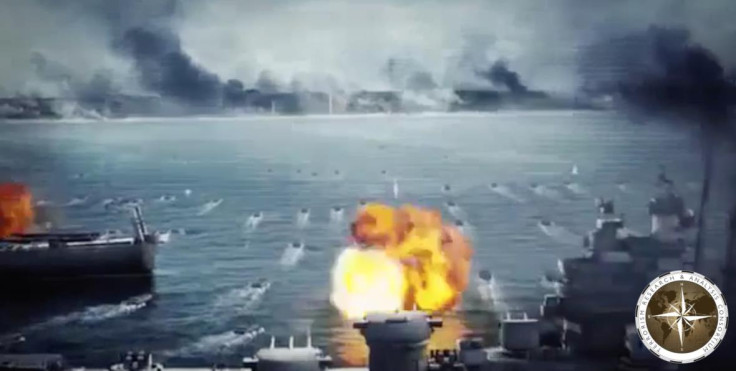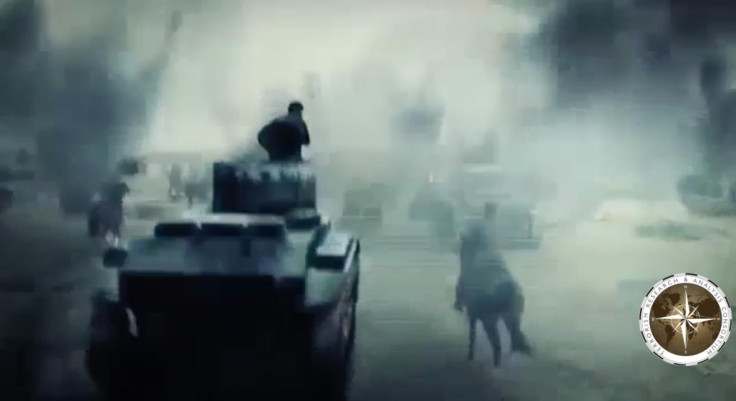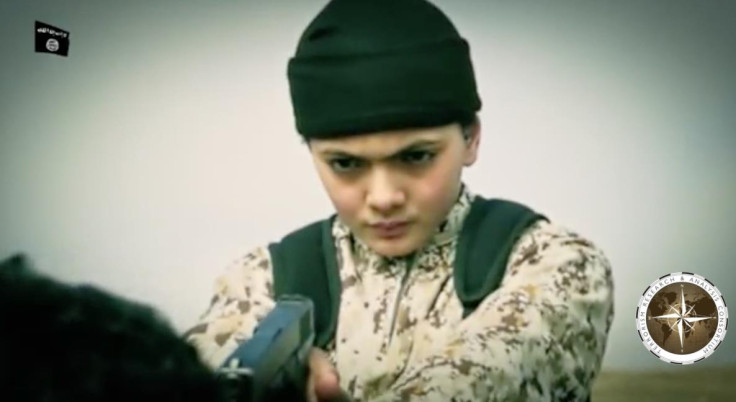The Hollywood of Isis: Jihadi film industry goes way beyond beheading videos

The Islamic State (Isis) has created a cult following with an insatiable appetite for its videos. It has enjoyed huge online success, based on the ability to create demand for what it can cheaply supply.
Part of this is providing a meta-narrative, a religiously rooted story in which each video genre invites you to enter the over-arching reality: The Rise of the Caliphate and Ultimate Perfection of the Ummah.
IS is just one of several terrorist groups competing for attention on an alternate virtual battlefront. Groups like al Qaeda in the Arabian Peninsula (AQAP) were among the first to take advantage of online promotion and recruitment and now look archaic by comparison. Jabhat al-Nusra (JN) is producing volumes and volumes of battle footage, but they ultimately cannot compete because their messaging does not have a larger narrative to convert consumers to volunteers.
Subjects and Series
Slick, high-profile execution videos receive the most media attention, but IS media produces other important genre videos, including child training camps, education classes in the Caliphate, man-on-the-street interviews, Kangaroo Courts, and soldiers in the field, in an effort to attract a variety of new followers.
Even in execution footage, the emphasis varies from simple and brutal punishment to diplomatic communiqués. Their audience is vast and the Isis fan club simply can't get enough. Long-standing series appeal to their viewership like soap operas.
Clanging of Swords is a feature-length series of preparation, assaults, and parades. Messages from the Land of the Living is another popular video series with personal messages and conversion stories; some older video series like Windows on the Land of Epic Battles, are 50 installments long and cover a vast array of topics, from reciting Quran competitions to Friday sermons to martyrdom operations.
If IS takes too long to put out another installment in the series, the fan club starts to clamour and complain, often reposting recycled material to remind the media production houses that they have not yet delivered on a promised new episode.
Recycling footage
The archives of the recorded videos are so wide-ranging that often Isis recycles video footage in order to refocus on new topics. It also recycles video footage to create video montages of "greatest hits", or to create an entirely new message from the exact same content. By combining older clips with new images or with CGI footage, Isis is able to 'puff itself up' to look even bigger than it already is, creating an alternate reality that they want the public to see.
Characteristics and messages
Characteristics of Islamic State videos depend on the genre; the execution videos are a good example.
Jihadi John's beheading videos—usually produced on a "green screen" are using his victims to send a diplomatic communiqué not just to the public at large but more specifically to the world's leaders. The executioner known as John gives long speeches before his act, sentences the accused before beheading them, and ends with a decree targeting the next victims.
But Jihadi John videos are merely one type of Isis execution videos; the most common preserved in the TRAC archives are the execution of spies. These are usually of the same high production value, but the message to the audience is both a warning to potential collaborators with enemies as well as to the true fans, who love to see someone punished for a bad deed.

In these videos, Isis executioners usually force the 'accused spy' to reenact his crime on film. Much like one sees in a television drama series, the soon-to-be-executed person pretends to explain a "flash back of events". These flashbacks are featured in between the 'confessional', another crucial component of the film.
A mysterious and important component of these videos is how calm the victims appear to be before their execution. Some victims are clearly drugged, but more importantly the victims go through endless dry-run rehearsals and they never really know when they will be killed. Presumably they are also secretly holding out the hope that the rehearsals are just for the filming, and they will not be executed.
One of the most shocking, and truly groundbreaking tactics in the world of terror, are the mass simultaneous beheading videos. What began as a novelty in the full-length feature film Even If the Disbelievers Despise Such has now become a mainstay in the Isis arsenal for terrifying people.
In Even If the Disbelievers Despise Such, the Islamic State featured 21 executioners of different nationalities, and their message was very clear: we are diverse, wide-spread, and powerful. This was such a popular approach for the Isis fan club that more mass simultaneous beheading videos were to follow: two in Libya and one very recently in Yemen. The latest messages were slightly different from those of their predecessor: we are not to be trifled with; you (the West) will be sorry for your actions; and get ready, world (especially Europe), we are coming for you next.

'The campaign is a holistic one, predicated on some of the western cultural cornerstones IS purports to despise. Images of gleaming shopping malls and succulent burgers in fast-food joints are liberally held up as examples of IS's subjects enjoying life under the black flag. The Daash propagandists haven't yet concocted an advert featuring a whistled ditty and the slogan 'I'm lovin' it', but they might as well have done.'
Read Veryan and Jasmine's article about IS's attempt to create the 'perfect caliphate' here.
In between these simultaneous beheading videos, the Islamic State released an execution video that was even more terrifying: the burning alive of a captive. In the video Healing the Believer's Chest, a Jordanian pilot, Lt. Moaz al-Kasasbeh, was caged, soaked in gasoline, and ignited. Unique in many ways, this is the first Islamic State video to use CGI (computer generated imagery) smattered throughout the film. In fact, the Islamic State had to use CGI cameras to film the burning.
Feared too grotesque even for an Isis audience, the editors chose to film the actual burning with CGI cameras. When a human burns, large fat bubbles come to the surface, so ISIS decided to manipulate the sheer unsightliness of the event. CGI equipment is very expensive and complicated to operate, and Healing of the Believer's Chest may have been the most pricey of all the Isis videos.
For months the Islamic State had produced "man on the street" interviews asking the general public within the state of Sham what should be done with the pilot, so in this case the execution was not only greatly anticipated, it also got double the coverage. Ironically, this execution might have backfired on the Isis PR machine, for there were as many critics within the fan club, denouncing this style of execution as un-Islamic, as there were supporters of the film. It also invoked, like never before, criticism from other religious peers or authorities who might have stayed out of their way had they not chosen to execute the pilot by brutally burning him.
Lastly, but certainly not least, are the execution videos featuring child executioners. To date, the Islamic State has released three very graphic, first of its kind, videos — all featuring hostage confessionals— slowly leading to the crescendo of a child shooting the hostage at close range. These have been powerful messages to their audience guaranteeing the future of the Caliphate because ISIS is raising a generation of new, well trained, and confident fighters capable of leading the Caliphate in the decades to come.

Strength
There is no doubt that Isis's strength in its video production lies with its producers, editors and directors. For the big budget releases, Isis uses a state-of-the-art machine that is also heavily used in Hollywood, an AVID editor. AVIDs are high tech, very expensive and very sophisticated.
The AVID contains over 70,000 functions, which require a team of editors to create a high-quality film. The "trailer" for Flames of War, released 16 September 2014, was much more sophisticated than any previous Isis film, indicating that either the Isis editors had mastered operating this complicated equipment or they brought in someone who did. Since that time, Isis has become more and more proficient in AVID production.
Weaknesses
A common pitfall of other social media users and Millennials is that they often share too much information, sometimes to their detriment. In the recent video on the invasion of the Baiji Oil Fields, Isis featured its "control room" which operated drones and reported to the soldiers in the field the locations of key enemy installations. This video let viewers into the inner workings of the Isis operation, and may have given away key secrets.

There is another danger for Isis here: that they are setting the bar too high, and will be unable to sustain the pace of the brutality. At some point Isis could start losing its audience, either by not producing videos fast enough, or by becoming too brutal in the constant doubling-down on the creativity of its violence. When you have upped the stakes so high, one can never admit when one is loosing ground. Whenever IS fails to perform, or loses a battle somewhere, it is forced to deflect its audience's attention.
IS's constant and high frequency video productions show the use of a variety of people in different environments, ranging from "war journalists" reporting from the battlefield to "event journalists" used in controlled areas to tell success stories. Footage is edited and presented by editorial teams, from which various media houses are then used to distribute the final version as official IS material.
The media houses include al-Hayat, often used for propaganda material to lure foreign fighters to Syria/Iraq; al Furqan, which is used for execution material; and Itisam, which covers the day-to-day life of IS fighters. Video production requires skills in a wide variety of fields such as photography, editing and production, none of which seems to be in short supply within the Caliphate.
Veryan Khan and Jasmine Opperman are senior directors for the Terrorism Research & Analysis Consortium (TRAC), one of the world's largest electronic compendiums for data and analysis of terrorist groups, activities, trends and up to date developments. By subscription, TRAC serves corporations, governments and military, universities, the media, and professionals. For complete information see www.trackingterrorism.org or follow the group on Twitter @TRACterrorism.
© Copyright IBTimes 2025. All rights reserved.




















